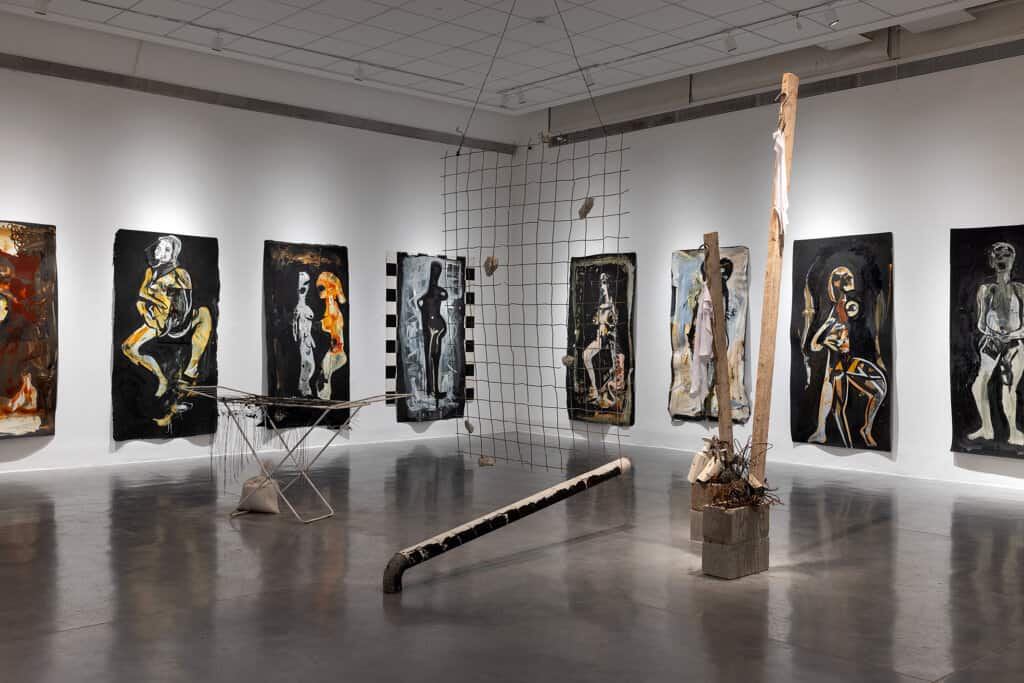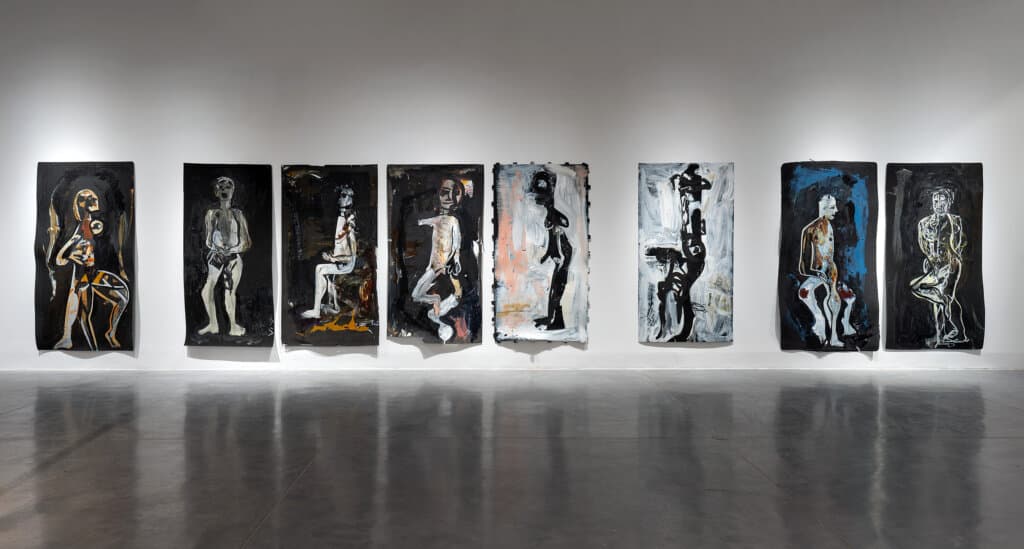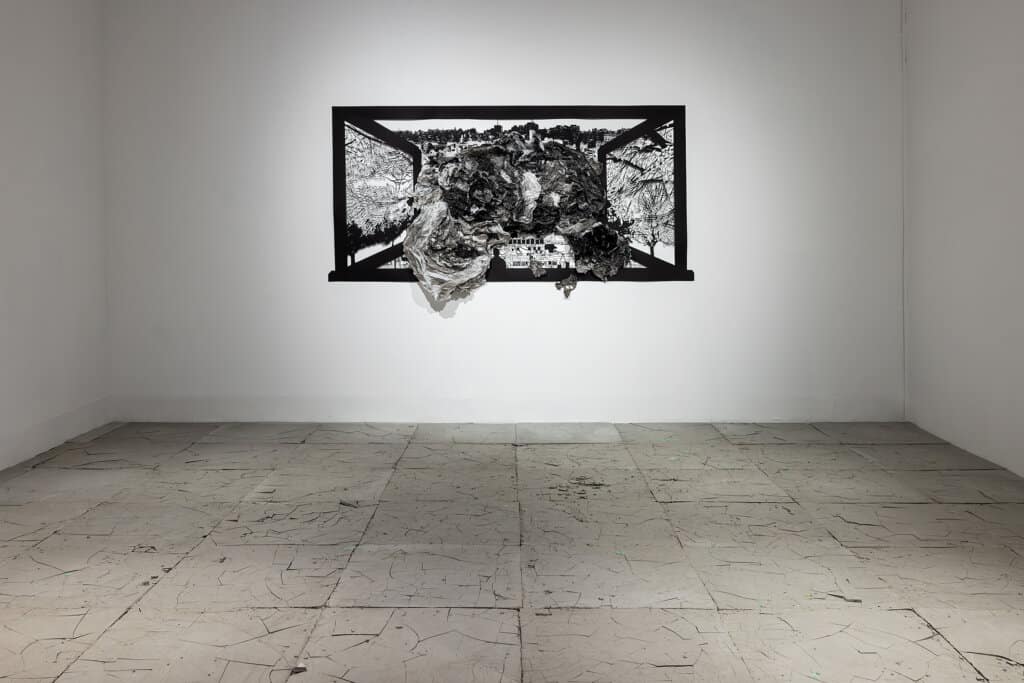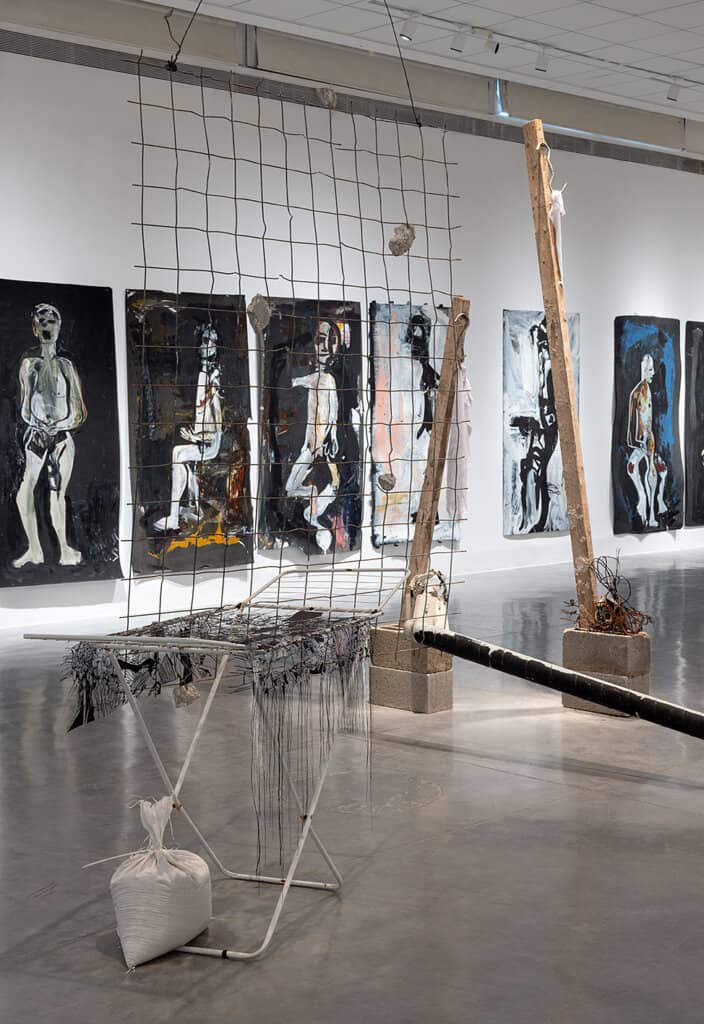Maria Saleh Mahameed, Noa Yekutieli, Tsibi Geva: Another Language
Curator: Irena Gordon
01/06/2023 -
25/11/2023

In recent years, Maria Saleh Mahameed, Noa Yekutieli, and Tsibi Geva have been conducting an artistic trialogue that has matured into an exhibition. Motivated by the need to perform an urgent artistic act, they respond to the violent, conflicted reality of the present time: an array of works by the three is installed in a shared space, bringing a blend of drawing and painting together with found raw materials such as concrete and rubber, associated with defense and survival structures. The coloration is fundamentally black. The images pertain to the human figure and its struggle for existence; to states of destruction, and the disruptive relationship between the intimate domestic indoors and the public outdoors.
The daughter of a Christian mother from Ukraine and an Arab-Muslim father who was born and raised in Umm el-Fahem, Maria Saleh Mahameed‘s paintings delve into identity and exile, motherhood and racism. She insists on drawing with charcoal, which is identified with her hometown, Umm el-Fahem, “the mother of charcoal,” and is directly influenced by the etching technique, a medium she uses to study the drawing gesture. She creates her works in manner that resembles action painting, stepping on the canvas, leaving her foot- and hand-prints on it. An epic presence of gradually accumulating scrolls unfolds her personal story as a woman, a mother, and an artist, as well as the collective story of life in Israel against the backdrop of the Israeli-Palestinian conflict, violence and crime in Arab and Jewish society, and the war in Ukraine. In Is This in Our Nature? the epic is thickened with another layer, when motifs recurring in her work—such as the mare and her own figure—are joined by new images of bound figures hovering in the expanses of the canvas, as if trying to detach themselves from the ground, as well as drawings of floating babies. Man and beast blend into hybrid creatures, as the painting transforms, for the first time, into a sculptural installation that floats in space.
Saleh Mahameed’s work fuses with that of Noa Yekutieli, who creates a quasi-domestic space installed inside a room, unfolding concurrent interior and exterior views, while subverting and cracking everything marked as “homely.” Yekutieli—the daughter of a Japanese mother and an Israeli father, who divides her time between the United States and Israel—grafts multicultural views on a reality of successive catastrophes. Implementing her artistic hallmark—manual paper-cutting—she creates meticulous panoramas, at once compressed and fragile, that combine natural scenes with manmade destruction. Through these intense landscapes she raises questions about mechanisms of denial and repression that serve man in situations of survival, examining the manner in which reality infiltrates our consciousness.
In the current exhibition, Yekutieli presents an immersive house-installation with a cracked concrete floor; its central wall bears a paper cutout of a huge window, reflecting billowing sights of destruction, its walls are covered with temporary plaster and fixed with a gutter that emits paper clippings. The “house” further contains a bookshelf with a heap of rubble, and a paper cutout carpet bearing a landscape of remains, suspended on a portable clothes drying rack. We are faced with a house in ruins, and its title—The Ground Couldn’t Hold a Home—refers to the imaginary and real registers of “being” and “stability.” Visitors are invited to step on the floor, feel its cracks under their feet, and take a closer look at the perspective of destruction in the window. The condensed traumatic states in view of one’s safe place collapsing, affects the ability to look at them head on.
Tsibi Geva‘s oeuvre refers to cultural aspects of the conflicted local landscape, giving them sculptural, material, and conceptual expressions. In a series of paintings created in the past year, partly featured in the exhibition, Geva turns to the personal, depicting the human body with an acerbic, blunt physicality that calls Picasso’s famous saying to mind: “I paint forms as I think them, not as I see them.” In his painting, hybrid-human figures constantly disintegrate and transform. For a split second they acquire an identifiable gender and shape, and in the next moment they renounce all definition. These fluid figures confront their very existence through the material from which they are made—acrylic and spray paints combined with collage on a black rubber surface, which is associated with Geva’s extensive use of tires and local building materials in his sculptures and installations as a cultural capsule that recounts a history.
The series unfolds a mental process of continuity between the painterly and the sculptural, between the background and the figurative image that seems to sprout from it. The figures are spawned in response to and from the surface, created and constructed gradually, as if giving birth to themselves and coming into being here and now, before our very eyes; constantly metamorphosing, as interior and exterior change places and invade one another. The body postures—front, back, side—are superimposed, echoing trends in 20th century modernist painting: Cubism, Abstract, Expressionism; Pablo Picasso, Willem de Kooning, Georg Baselitz. The various metamorphoses of the depicted figures invite a multitude of readings and interpretations, in a dialectical movement between the defined-whole and that which is cut-split.
The title of the exhibition, “Another Language,” was extracted from Bertolt Brecht’s poem “When Evil-Doing Comes Like Falling Rain,” discussing the numbing habit and the stupor vis-a-vis the atrocious actions of humans. The prophet at the gate tries to shout, but his words are not heard, as he speaks another language, to which other people are not attentive. “When evil-doing comes like falling rain, nobody calls out ‘stop!’ / When crimes begin to pile up they become invisible. When sufferings become unendurable the cries are no longer heard. The cries, too, fall like rain in summer.” (trans. John Willett). The three artists present the other language in painterly, sculptural, and multimedia structures, forming a material and psychological array in a shared space.
Tsibi Geva was born in Kibbutz Ein Shemer, 1951; lives and works in Tel Aviv | Noa Yekutieli was born in Fountain, Indiana, 1989; lives and works in New York and Tel Aviv | Maria Saleh Mahameed was born in Umm el-Fahem, 1990; lives and works in Ein Mahel.



Installation photographs: Elad Sarig

